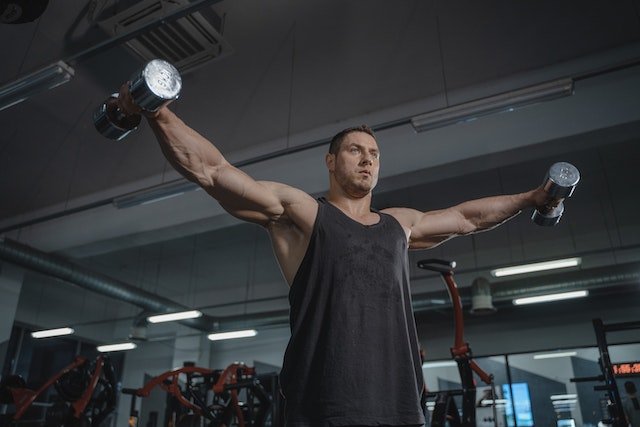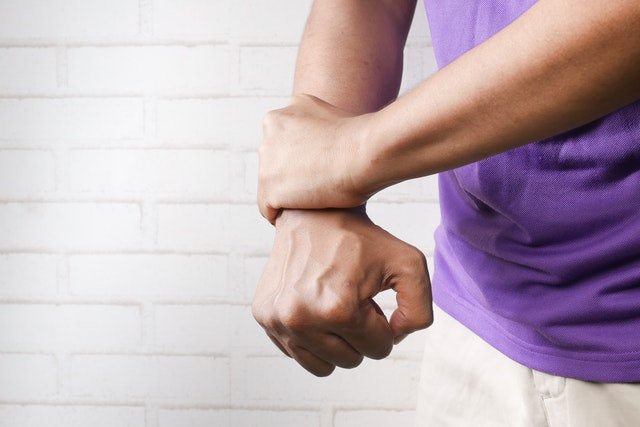
Wrist Pain From Lateral Raises? 9 Tips For Progress
Are you fed up with wrist pain from lateral raises? If so don’t worry, you’re not alone. Plenty of people suffer from wrist pain and discomfort when it comes to lateral raises, but don’t despair – there are solutions!
In this blog, we’ll take a look at why some people struggle with their lateral raises and how to strengthen them progressively and safely so that you can benefit from the many advantages a well-executed lateral raise provides. So read on if you want to get those deltoids in shape for better overall fitness!
Why Do I Get Wrist Pain From Lateral Raises?
The main cause of wrist pain when doing lateral raises can be attributed to weak wrists. When performing the exercise, you are required to keep your wrists in a neutral position throughout the movement, meaning that if your wrists lack strength and stability, you may experience discomfort or even pain. Another common cause of wrist pain while doing lateral raises is using a grip that is too tight or using a weight that’s too heavy for you to do the exercise correctly. If your grip is too tight, it can put too much strain on your wrists and lead to pain. Similarly, if you are lifting more than you can handle, this may result in your wrists being strained and therefore causing pain. Wrist pain can be a result of excessive repetition, as your wrists may become exhausted from the strain caused by such high-volume reps and sets. Finally, not warming up before doing the exercise or having an existing wrist injury can also be the cause of wrist pain when doing lateral raises.
If your wrists hurt during or after doing lateral raises, it’s normally down to something simple that can be cured with a little bit of tweaking. Here is a quick guide to help you get your lateral raises right and avoid any uncomfortable wrist pain…
1. Wrist flexion
Many people unconsciously bend their wrists when doing this exercise, which can cause unnecessary strain and discomfort in the wrists. Wrist flexion places extra stress on the tendons and ligaments, which can lead to pain.
The term “Wrist flexion” is the act of bending the hand down at the wrist with your palms facing the underside of your forearm. To avoid wrist flexion and the pain that comes with it, keep your wrists straight (neutral) throughout the entire exercise.
Try clenching your fist (not too hard) while your wrist is in a neutral position, feels ok right? Then do the same while your wrist is in flexion. It feels very uncomfortable straight away, doesn’t it?
Now think about holding a dumbbell at the same time, you see how painful wrist flexion can be when doing lateral raises.
The main reasons you might experience wrist flexion would be down to using too much weight, having a grip on the bar that is too tight or lacking the strength in your wrists to maintain the neutral position. You can work on strengthening and stabilising your wrists by incorporating wrist flexion exercises into your regular workout routine.
2. Weak wrists
If the lateral raise is new to you, then your wrists will naturally feel weaker while they get used to the exercise and new stimulus that’s been placed upon them. A good way to build up the strength in your wrists is to start with a lighter weight or even no weight at all and progress gradually, as this will help avoid any unnecessary strain or discomfort.
Having weak wrists can make it difficult to keep your wrists in the neutral position when doing lateral raises. Luckily, there are some simple exercises you can do that will help strengthen and stabilise them.
Wrist curls and reverse wrist curls (where you curl the barbell with your palms facing down) are two of the best exercises for strengthening your wrists. You should also incorporate forearm stretches into your warm-up routine, as these can help reduce stiffness in the wrists.
Farmers’ walks, kettlebells and dead hangs are also great exercises for strengthening your wrists and improving your grip strength, as these can help build up your wrist muscles and improve stability.

3. Too heavy
Using a set of dumbells or loading too much weight on the cable machine can put too much pressure on your wrists, causing discomfort or pain.
If the weight is too heavy it will force your wrists into flexion, which as we already know can be painful. If you’re finding that the weight is too heavy, try dropping it down to a lighter weight and make sure your grip on the bar isn’t too tight.
Remember, it’s always better to use a weight that you can control throughout the whole exercise than one that forces your wrists into flexion.
If you find the weight you are using is too heavy for your wrists, reduce the load and focus on performing each rep with perfect form, slowly raising and lowering the dumbbells in a controlled manner. As your wrist strength improves, gradually increase the weight to ensure that you are challenging yourself, without risking injury.
4. Get a grip
Having a strong grip when doing lateral raises is essential for proper form, however, gripping the bar too tightly can put unnecessary strain on your wrists. You want to make sure you have a good grip on the handle but not to the point where it turns your knuckles white.
You may be aware that clenching your fists for extended periods of time can cause discomfort and even lead to wrist pain, and gripping a dumbbell too tight has the same effect.
To avoid this, use a firm and comfortable grip on the handle while performing the lateral raises. This will help keep your wrists in a neutral position, reduce tension on them and allow you to perform the exercise with better form.
If you apply too much pressure to the handle for an extended period of time, not only will your wrists be exhausted but also your grip, forearms, biceps and triceps could be at risk. So be mindful of how hard you’re gripping!
On the flip side, if you have a weak grip on the dumbbells during lateral raises, it can cause your wrists to bend excessively. This will not only be uncomfortable but can also lead to potential injuries down the line if you don’t take action.
Related: Should I Train Shoulders After Chest?
5. Consider straps
If you find your grip is too weak even when using light weights, then consider using lifting straps. Straps are a great way to provide extra support for your wrists while doing lateral raises and other exercises that require a lot of gripping.
Lifting straps can help keep the weight balanced on the bar and help reduce strain on your wrists. They also make it easier to keep the weights in a neutral position and hold them in place while you perform the exercise, making it more comfortable and less stressful on your wrists.
However, some people think that you shouldn’t use straps as they can lead to a false sense of security and reduce your overall grip strength.
If you choose to use straps, make sure you don’t rely on them too much. Use them only when necessary and focus on building up your wrist strength before doing lateral raises with heavier weights.
6. No warm-up
It’s important to include a warm-up in your exercise routine to help your body prepare for the workout. This is especially true when it comes to exercises that involve a lot of grip strength, such as lateral raises.
Performing some wrist stretches and dynamic movements like arm circles or wrist rotations can help increase blood flow to the wrists and loosen up the muscles and joints before you begin. This can help reduce tightness in the wrists and prevent any discomfort or pain during the exercise.
All too often people only begin to take the time to warm up correctly after they have suffered an injury (myself included here) when realistically, taking just five minutes before a workout can go a long way to preventing injury and discomfort.

7. Previous injury
If you have a previous injury to your wrists, it is important to take extra precautions when doing lateral raises. If the cause of your pain is due to an underlying condition such as Carpal Tunnel Syndrome or tendonitis, then consult with your doctor for advice before continuing with the exercise.
In some cases, you may need to modify the exercise or use different equipment to prevent further injuries. Your doctor can also provide guidance on ways to strengthen your wrists and other muscles to reduce pain when doing lateral raises.
One way to remove your wrists when doing lateral raises would be by putting a velcro ankle band around your wrist, and then attaching it to a cable machine to do the exercise. This completely removes the wrists from the exercise as you are lifting with your forearm and not with your hand.
8. Too much volume
If you are doing a lot of volume (sets and reps) for lateral raises, this could be the cause of your wrist pain. When you do a high volume of any exercise, your muscles and joints will become fatigued and this can lead to discomfort and pain.
To avoid this, it is important to listen to your body and take breaks when needed. If your wrists start to hurt during the exercise, take a break and give them a rest. You can also try reducing the number of sets and reps you do, or using lighter weights to make the exercise easier on your wrists.
If you find that your wrist pain is persistent, it is important to consult with a doctor or physiotherapist to rule out any underlying conditions. Once you have ruled out any serious injuries, they can provide guidance on how to modify the exercise or stretches to help reduce wrist pain.
Most people will experience some form of discomfort in their wrists when doing lateral raises at some point. However, if the pain is severe or persists, it is important to take a break and investigate the cause of the pain.
Related: Why do I feel shoulder press in my lats?
9. Overuse
Another reason your wrists may hurt when doing lateral raises is from overuse from day-to-day tasks. If you are a typist or use your hands constantly throughout the day for manual labour etc, these can lead to tightness in the wrists and could be causing your pain.
Overuse can lead to carpal tunnel syndrome, tendonitis, arthritis and other conditions that can cause wrist pain. It is important to recognise when your wrists are overworked and take the time to stretch them out and do exercises to strengthen them.
Final thoughts…
When you experience pain in your wrists during lateral raises, it might be an indication of weak or overworked wrists. Because of this, it’s crucial that you warm up your muscles and joints before any workout routine, as well as strengthening your wrists with targeted exercises.
If you do suffer from wrist pain when doing lateral raises, be sure to take a break and consult with your doctor or physiotherapist for further guidance on how to reduce the pain. By taking these precautions, you should be able to perform lateral raises without any persistent wrist pain.
Have your wrists hurt after doing lateral raises and have these tips helped? Let me know in the comments section below.


